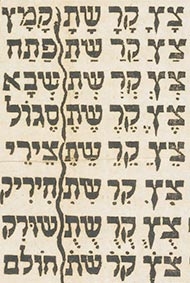100 Years, 11 Languages, 22 Artworks, No English

The Language Schools at the Art Museum
May 22–August 9, 2015
For immediate release: 3/4/15
For further information contact: Pieter Broucke, Associate Curator, at broucke@middlebury.edu or (802) 443-5227, or Peter Moore ’14, Sabarsky Graduate Fellow, at pmoore@middlebury.edu or (802) 443-5561
Middlebury, VT—This summer, Middlebury College celebrates the centennial of the Language Schools that, each summer, transform the campuses in Middlebury, Vermont, and at Mills College, California, into global villages where virtually no English can be heard. The German school was founded in 1915. In subsequent summers French, Spanish, Italian, Russian, Chinese, Japanese, Arabic, Portuguese, and Hebrew were added. Korean is being offered for the first time this summer.
The Middlebury College Museum of Art joins in the centennial celebrations with an exhibition entitled The Language Schools at the Art Museum, open to both on- and off-campus audiences from May 22 to August 9. The exhibition is curated by Associate Curator of Ancient Art Pieter Broucke and Sabarsky Graduate Fellow Peter Moore ’14.
From the outset, the curators aimed to create a single, cohesive exhibition celebrating the centennial of the Language Schools as a whole, rather than creating 11 miniature exhibitions, one for each language. The result is a rich constellation of works of art and displays of languages that, taken together, form a comprehensive visual experience that spans nearly two millennia of globe-encompassing artistic production.
For the exhibition, the curators selected 22 works of art from the museum’s permanent collection, two per language. For each language, the curators aimed at including one work that is typical and representative, the other less typical and somewhat surprising; one work that is more historical, the other more modern or contemporary; one that contains language and one that does not; and, when relevant, one that is from where a language originated and one from where the language (or an artist) migrated.
To fulfill this curatorial objective the museum had to add some works of art to its collection, especially for the more recently introduced languages. For instance, for Portuguese the museum acquired two figurative Rococo tile sets from Coimbra, Portugal’s erstwhile capital; an early 18th-century Hebrew alphabet chart made in Germany; and for Korean a writing-covered interpretation of the four seasons, a work by contemporary artist Hyun-Hee Lee.
In addition to the works themselves, each language also has the exhibition’s introductory texts displayed in the gallery. The two works of art selected for each language, moreover, are provided with object labels in their respective language. As a result, the languages and their writing systems themselves are, alongside their works of art, prominently featured in the exhibition.
In keeping with the “No English Spoken Here” pledge that underlies the time-tested pedagogy of Middlebury’s Language Schools, not a word of English is displayed in the exhibition, though a handout with translations of the introductory text and all labels is made available in the gallery.
The Middlebury College Museum of Art, located in the Mahaney Center for the Arts on Rte. 30 on the southern edge of campus, is free and open to the public Tues. through Fri. from 10 a.m. to 5 p.m., and Sat. and Sun. from noon to 5 p.m. It is closed Mondays. The museum is physically accessible. Parking is available in the Mahaney Center for the Arts parking lot. For further information and to confirm dates and times of scheduled events, please call (802) 443–5007 or TTY (802) 443–3155, or visit the museum’s website at museum.middlebury.edu.
